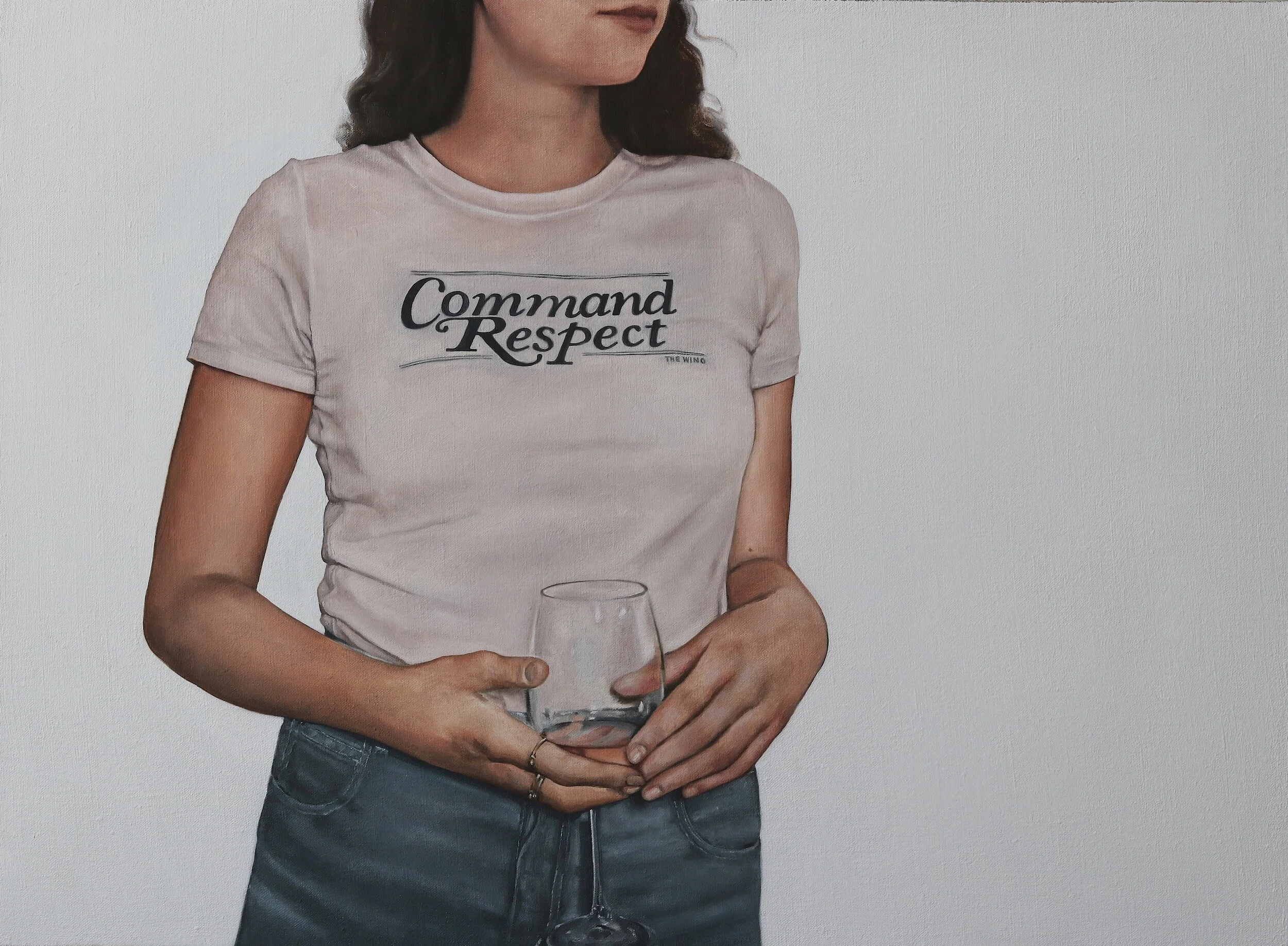ODE TO THE T-SHIRT 2018-2019
Frayed Edges of Neat Knot, 48 x 60 inches, oil on linen, 2018, sold
Unrhymed Poetry, 48 x 60 inches, oil on linen, 2019, sold
Louder Than Ever, 22 x 30 x 1.5 inches, oil on linen, 2018, sold
Relief from the Authority of Things, 22 x 30 x 1.5 inches, oil on linen, 2018, sold
Born a Feminist, 30 x 40 inches, oil on linen, 2019, sold
I Do Not Press My Finger Across My Mouth, 22 x 30 x 1.5 inches, oil on linen, 2018, sold
The Embrace of Love and Resistance, 22 x 30 x 1.5 inches, oil on linen, 2018
Most Wonderful in his Half-Hidden Smile or Frown, 22 x 30 x 1.5 inches, oil on linen, 2018, sold
Hip Hip Hooray, 14 x 11 x 0.75 inches, oil on canvas, 2017, sold
Smile For Me Blondie, 14 x 11 x 0.75 inches, oil on canvas, 2017, sold
Bad Bitch, 11 x 14 x 0.75 inches, oil on linen, 2017, sold
Full of Truth and Revelation, 14 x 11 x 0.75 inches, oil on linen, 2018
Just Wonderful, 14 x 11 x 0.75 inches, oil on linen, 2018, sold
100%, 11 x 14 x 0.75 inches, oil on canvas, 2017
Ode to the T-Shirt is a series of paintings that exemplifies how our clothes, accessories, and more specifically t-shirts, represent unspoken forms of communication as tools of self-expression and representation. Similar to the way in which we communicate with our smartphones, T-shirts represent the decline of the spoken word and a rise in verbalizing our opinions through non-verbal forms of communication. How do we say things without really having to say them? Similar to Instagram, Facebook, Twitter, blogs, texts, emojis, and countless other modern apps just a touch of a screen away, we use clothes as a form of self-expression allowing complete strangers to opine on us without the courtesy of a conversation. They are a vehicle for verbal confrontation while avoiding vocal confrontation.
For centuries fashion has served as a model of self-expression and a major way in which we express ourselves creatively; but recently the way we dress has taken on a more political edge. In the last few years, there has been a specific rising trend in graphic t-shirts vocalizing a strong point of view. Verbiage has introduced itself into our clothes, allowing us to plaster our opinions across our chests. It has become a small, yet strikingly clear, symbol of our zeitgeist. Now more than ever, people are wearing their hearts on their sleeves, literally. T-Shirts and clothing in general can be considered a type of Lingua Franca: a language that is adopted as a common language between speakers whose native languages are different. T-shirts serve as a form of common language because they allow you to voice your opinion silently but prominently. They can be a form of protest, opinion, expression, joy, inspiration, fact, or anything you really want them to be. They are the perfect blank canvas for visually voicing your opinions and reinforcing your identity, no matter who you are.
In this series, Helen’s work explores the nature of representation and the limitless potential of the human figure as a subject. She uses non-traditional portraiture to consider modes of representation and self-expression. Her paintings are all derived from photographs and studies and are documentary in style. The paintings in this series lack a countenance element and are therefore non-confrontational in comparison to a traditional portrait. Helen chooses to represent her subjects through what they are wearing in order to demonstrate personal expression. By omitting the face, these paintings evolve from just traditional portraits. Instead of focusing on the way someone looks, Helen hopes to represent her subject’s personality and ideology. Along with creating a portrait of her subject’s character, her paintings seek to create a relationship between artwork and viewer. Despite depicting real people, her paintings imply a human presence without actually identifying a specific person. The person in the painting is someone, but at the same time, can be no one. Without major identifying facial features, the figures in her paintings become ciphers for her viewer’s own imaginative range of memories and interpretations. The t-shirt in the painting no longer belongs to the model, but rather the viewer.
Be Happy, 8 x 12 inches, graphite on watercolor paper, 2017
The Future Is Female, 8 x 12 inches, graphite on watercolor paper, 2017, sold
Human, 8 x 12 inches, graphite on watercolor paper, 2017, sold
Command Respect, 24 x 30 x 0.75 inches, oil and embroidery floss on linen, 2017, sold
Voices Veiled and I Remove the Veil, 12 x 12 inches, oil and embroidery floss on canvas, 2017, sold
Girl Power II, 8 x 16 x 1.5 inches, oil and embroidery floss on linen, 2018, sold
Girl Power II, 8 x 16 x 1.5 inches, oil and embroidery floss on linen, 2018, sold
I Believe In You, 24 x 30 x 0.75 inches, oil on linen, 2017, sold
